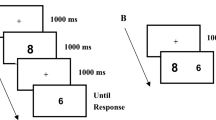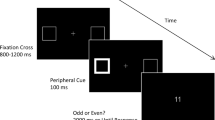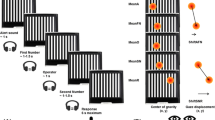Abstract
Number processing induces spatial attention shifts to the left or right side for small or large numbers, respectively. This spatial-numerical association (SNA) extends to mental calculation, such that subtractions and additions induce left or right biases, respectively. However, the time course of activating SNAs during mental calculation is unclear. Here, we addressed this issue by measuring visual position discrimination during auditory calculation. Thirty-four healthy adults listened in each trial to five successive elements of arithmetic facts (first operand, operator, second operand, equal and result) and verbally classified their correctness. After each element (except for the result), a fixation dot moved equally often to either the left or right side and participants pressed left or right buttons to discriminate its movement direction (four times per trial). First and second operand magnitude (small/large), operation (addition/subtraction), result correctness (right/wrong) and movement direction (left/right) were balanced across 128 trials. Manual reaction times of dot movement discriminations were considered in relation to previous arithmetic elements. We found no evidence of early attentional shifts after first operand and operator presentation. Discrimination performance was modulated consistent with SNAs after the second operand, suggesting that attentional shifts occur once there is access to all elements necessary to complete an arithmetic operation. Such late-occurring attention shifts may reflect a combination of multiple element-specific biases and confirm their functional role in mental calculation.


Similar content being viewed by others
Notes
Following this design, the probability to perform a subtraction or an addition after hearing a large or a small number was the same.
References
Anelli F, Lugli L, Baroni G, Borghi AM, Nicoletti R (2014) Walking boosts your performance in making additions and subtractions. Front Psychol 5:1459. https://doi.org/10.3389/fpsyg.2014.01459
Cohen J (1988) Statistical power analysis for the behavioral sciences, 2nd edn. Lawrence Erlbaum Associates, Hillsdale
Cohen Kadosh R, Dowker A (2015) The Oxford handbook of numerical cognition. University Press, Oxford
Cowan N (1984) On short and long auditory stores. Psychol Bull 96:341–370
Dehaene S (2011) The number sense: how the mind creates mathematics, 2nd edn. Oxford University Press, New York
Dehaene S, Bossini S, Giraux P (1993) The mental representation of parity and number magnitude. J Exp Psychol Gen 122(3):371–396
Dehaene S, Naccache L, Le Clec’H G, Koechlin E, Mueller M, Dehaene-Lambertz G et al (1998) Imaging unconscious semantic priming. Nature 395:597–600
Faul F, Erdfelder E, Lang AG, Buchner A (2007) G*Power 3: a flexible statistical power analysis program for the social, behavioral, and biomedical sciences. Behav Res Methods 39:175–191
Fischer B, Breitmeyer BG (1987) Mechanisms of visual attention revealed by saccadic eye movements. Neuropsychologia 25:73–83
Fischer MH, Shaki S (2014) Spatial associations in numerical cognition-From single digits to arithmetic. Q J Exp Psychol 67:1461–1483
Groen GJ, Parkman JM (1972) A chronometric analysis of simple addition. Psychol Rev 79(4):329–343
Hartmann M, Mast FW, Fischer MH (2015a) Counting is a spatial process: evidence from eye movements. Psychol Res 80:399–409. https://doi.org/10.1007/s00426-015-0722-5
Hartmann M, Mast FW, Fischer MH (2015b) Spatial biases during mental arithmetic: evidence from eye movements on blank screen. Front Psychol 6:12
Knops A, Viarouge A, Dehaene S (2009) Dynamic representations underlying symbolic and nonsymbolic calculation: evidence from the operational momentum effect. Atten Percept Psychophys 71(4):803–821
Liu D, Cai D, Verguts T, Chen Q (2017) The time course of spatial attention shifts in elementary arithmetic. Sci Rep 7:921. https://doi.org/10.1038/s41598-017-01037-3
Masson N, Pesenti M (2014) Attentional bias induced by solving simple and complex addition and subtraction problems. Q J Exp Psychol 67:1514–1526. https://doi.org/10.1080/17470218.2014.903985
Masson N, Pesenti M (2016) Interference of lateralized distractors on arithmetic problem solving: a functional role for attention shifts in mental calculation. Psychol Res 80(4):640–651
Masson N, Letesson C, Pesenti M (2018) Time course of overt attentional shifts in mental arithmetic: evidence from gaze metrics. Q J Exp Psychol 71(4):1009–1019. https://doi.org/10.1080/17470218.2017.1318931
Mathieu R, Gourjon A, Couderc A, Thevenot C, Prado J (2016) Running the number line: rapid shifts of attention in single-digit arithmetic. Cognition 146:229–239
McCrink K, Dehaene S, Dehaene-Lambertz G (2007) Moving along the number line: operational momentum in nonsymbolic arithmetic. Percept Psychophys 69:1324–1333
Nuerk H-C, Moeller K, Klein E, Willmes K, Fischer MH (2011) Extending the mental number line: a review of multi-digit number processing. J Psychol 219(1):3–22
Pinhas M, Fischer MH (2008) Mental movements without magnitude? A study of spatial biases in symbolic arithmetic. Cognition 109:408–415
Pinhas M, Shaki S, Fischer MH (2014) Heed the signs: operation signs have spatial associations. Q J Exp Psychol 67:1527–1540. https://doi.org/10.1080/17470218.2014.892516
Posner MI, Petersen SE, Fox PT, Raichle ME (1988) Localization of cognitive operations in the brain. Science 240:1627–1631
Reynvoet B, Brysbaert M, Fias W (2002) Semantic priming in number naming. Q J Exp Psychol 55A(4):1127–1139
Shaki S, Fischer MH (2014) Random walks on the mental number line. Exp Brain Res 232:43–49
Shaki S, Pinhas M, Fischer MH (2017) Heuristics and biases in mental arithmetic: revisiting and reversing operational momentum. Think Reason. https://doi.org/10.1080/13546783.2017.1348987
Tversky A, Kahneman D (1974) Judgment under uncertainty: heuristics and biases. Science 185:1124–1131
Uittenhove K, Thevenot C, Barrouillet P (2016) Fast automated counting procedures in addition problem solving: when are they used and why are they mistaken for retrieval? Cognition 146:289–303
Watkins OC, Watkins MJ (1980) The modality effect and echoic persistence. J Exp Psychol Gen 109:251–278
Funding
This study was funded by “Competing heuristics and biases in mental arithmetic” (Grant No. DFG FI_1915/8-1).
Author information
Authors and Affiliations
Corresponding author
Ethics declarations
Conflict of interest
The authors declare that they have no conflict of interest.
Human and animal rights
All procedures performed in studies involving human participants were in accordance with the ethical standards of the institutional and/or national research committee and with the 1964 Helsinki Declaration and its later amendments or comparable ethical standards.
Informed consent
Informed consent was obtained from all individual participants included in the study.
Additional information
Publisher's Note
Springer Nature remains neutral with regard to jurisdictional claims in published maps and institutional affiliations.
Handling editor: Juan Lupiáñez (University of Granada).
Reviewers: Pom Charras (University Paul Valery Montpellier) and a second researcher who preferred to remain anonymous.
Rights and permissions
About this article
Cite this article
D’Ascenzo, S., Lugli, L., Nicoletti, R. et al. Assessing orienting of attention to understand the time course of mental calculation. Cogn Process 21, 493–500 (2020). https://doi.org/10.1007/s10339-020-00970-y
Received:
Accepted:
Published:
Issue Date:
DOI: https://doi.org/10.1007/s10339-020-00970-y




